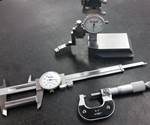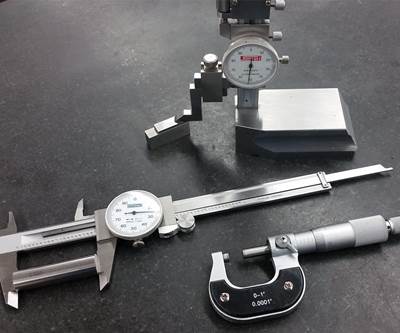Apprentice Training Series: Manual Machining
Manual, in-depth machine training instills critical skills in innovation and problem solving.
I have had the good fortune of working closely with thousands of skilled CNC machinists, die makers, moldmakers, fixture builders, designers and engineers throughout the course of my career. One thing I’ve learned is that those who have extensive training and experience with manual machining equipment possess a distinct advantage in their ability to innovate and problem solve. That moved me to advocate for mandating in-depth manual machine training as part of every apprenticeship program that involves machining.
Here are a few essential components of a manual machining class:
Safety. First and foremost, the class should address machine-specific safety rules. General shop safety rules are typically not specific enough when referring to manual equipment work. A simple Google search of “machine shop safety” will offer up any number of excellent sites to help one develop machine-specific safety rules for a class or to give the apprentices.
Drill press. The manual drill press has abilities that many often overlook. It is a versatile machine that can get a machinist out of a jam quickly and accurately, if the machinist knows how to use it appropriately. With the proper layout techniques and job setup, a good machinist can easily drill and ream a hole within a 0.002-inch location tolerance. Using a manual drill press is therefore a good exercise for students, and it is why I require students to use one in my classes. I ask each student to create a block sample in such a way that requires all the standard skills of using a drill press, like layout, prick-punch, center-punch, center drilling, drilling, reaming, chamfering, countersinking, tapping and counterboring. Students then check each hole for accurate location, proper form and function.
Job setup is another critical task to emphasize in training. The apprentice must understand when and when not to use vises, strap clamps, angle plates or any other setups.
Pedestal grinder. Perhaps it is because of the pride I have as machinist that I believe that every person who works with metal-cutting machines should know how to sharpen a high-speed steel drill bit. All too often I hear machinists questioning why they would need to know that when a drill doctor is available. Learning how to sharpen a drill bit by hand teaches the machinist how steel is cut. It also teaches the machinist the importance of relief and approach angles, chip evacuation and the overall function of a metal cutting tool.
Manual mill. Fifteen years ago, while the educational world debated whether to eliminate manual machining from shop classes and offer CNC machining only, a friend and mentor argued that learning to use the manual mill requires involvement of more human senses than other types of machining. That immersion of the senses helps students to retain what they learn. For example, when turning the handles of a manual mill a machinist can see the cut, hear the cut, feel the cut and even smell the cut. This creates a powerful association that helps the machinist recognize cutter wear, surface finish and vibration issues quicker on a CNC machine. Engagement of the senses makes machinists more intuitive. Learning a manual milling machine also teaches the student more about the variables that can affect part accuracy, such as setup and head squareness.
Practically speaking, every student should be able to perform certain machining tasks. This includes tramming the head of a mill, setting up and indicating a precision vise and angle plate, using strap clamps, recognizing the differences between climb and conventional cutting, understanding the reasons a machinist does not climb cut on a manual mill, squaring a block, cutting slots, performing all drilling operations, compensating for backlash and most of all, holding a tight tolerance.
Engine lathe. The ability to run an engine lathe is one of the most useful skills to have during a “panic” situation in the mold shop. Moldmakers do not use lathes often in the shop other than for special applications. Still, taking the time to learn how to turn an accurate part properly and pick up some additional skills is worth the effort, particularly when there isn’t time to special order a part. The basics of learning the engine lathe should include mastering all drilling operations: facing, turning a diameter, turning a taper, and internal and external threading and boring.
Surface grinder. The surface grinder is my final recommendation for manual machine training because it gives the machinist an appreciation for accuracy, tolerances and surface finish. At a minimum, the student should learn to dress a wheel with a diamond dresser, set up a job, block the job in when necessary, square a block with or without using an angle plate, set up and grind angles with a sine plate and grind pins.
Projects are key for helping students learn the skills required on each individual machine. Many shop classes have students make 1-2-3 blocks, angle plates, hammer heads and hammer handles, which end up as useful tools in the shop. I strongly encourage one functional project that requires the use of all the machines, like a precision vise, for example. This teaches students the importance of tolerances and requires them to manufacture complimentary parts that must function with other parts. The vise requires squared blocks, milled and surface ground angles, a threaded rod and numerous other details that incorporate manual machining skills on multiple machines.
The multitude of variables involved in running a manual machine also teaches students to problem solve logically. Above all, running manual equipment teaches students patience, which in turn teaches students the appropriate use of aggression and finesse when machining. After years of teaching, I can say that everything students learn on a manual machine will translate to improved skills on a CNC machine as a moldmaker, designer or engineer.
Related Content
Hands-on Workshop Teaches Mold Maintenance Process
Intensive workshop teaches the process of mold maintenance to help put an end to the firefighting culture of many toolrooms.
Read MoreMaking Quick and Easy Kaizen Work for Your Shop
Within each person is unlimited creative potential to improve shop operations.
Read MoreHow to Use Scientific Maintenance for More Accurate Mold and Part Troubleshooting
Discover how adopting scientific maintenance approaches helps improve mold lifespan, minimize failures, and optimize production outcomes.
Read MoreThe Role of Social Media in Manufacturing
Charles Daniels CFO of Wepco Plastics shares insights on the role of social media in manufacturing, how to improve the “business” side of a small mold shop and continually developing culture.
Read MoreRead Next
Apprentice Training - Precision Inspection and Measurement
Here are some basic principles concerning inspection and measurement to take into account when developing your related technical instruction (RTI) plan.
Read MoreReasons to Use Fiber Lasers for Mold Cleaning
Fiber lasers offer a simplicity, speed, control and portability, minimizing mold cleaning risks.
Read MoreHow to Use Continuing Education to Remain Competitive in Moldmaking
Continued training helps moldmakers make tooling decisions and properly use the latest cutting tool to efficiently machine high-quality molds.
Read More





















